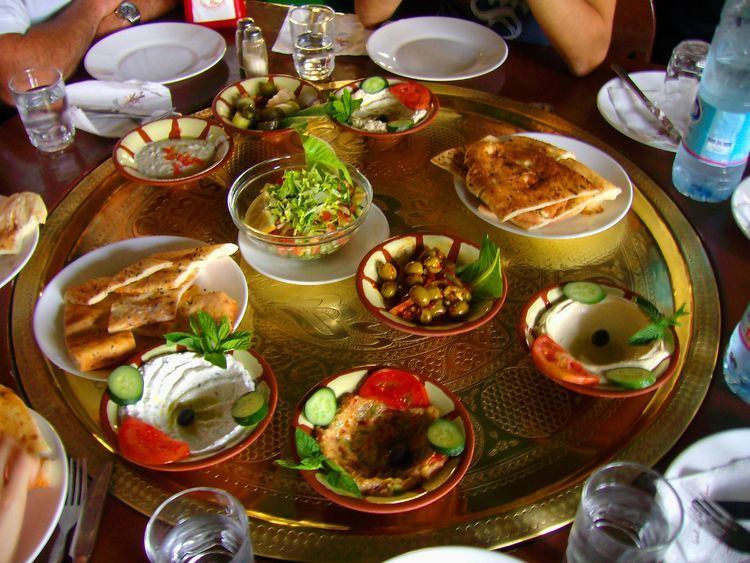 | ||
Jordanian cuisine is a traditional style of food preparation originating from, or commonly used in Jordan that has developed from centuries of social and political change.
Contents
There is wide variety of techniques used in Jordanian cuisine ranging from baking, sautéeing and grilling to stuffing of vegetables (carrots, leaves, eggplants, etc.), meat, and poultry. Also common in Jordanian cuisine is roasting or preparing foods with special sauces.
As one of the largest producers of olives in the world, olive oil is the main cooking oil in Jordan. Herbs, garlic, onion, tomato sauce and lemon are typical flavours found in Jordan. The blend of spices called za'atar contains a common local herb called Sumac that grows wild in Jordan and ia closely identified with Jordanian and other Mideastern cuisines. Yogurt is commonly served alongside food and is a common ingredient itself, in particular, jameed, a form of dried yogurt is unique to Jordanian cuisine and a main ingredient in Mansaf the national dish of Jordan, and a symbol in Jordanian culture for generosity.
Another famous Meat dish in Southern Jordan especially in the Bedouin Desert area of Petra and Wadi Rum is the Zarb which is prepared in a submerged oven also called a "taboon". It is considered a delicacy of that area.
Internationally known foods which are common and popular everyday snacks in Jordan include hummus, which is a puree of chick peas blended with tahini, lemon, and garlic and falafel, a deep-fried ball or patty made from ground chickpeas. A typical mezze includes foods such as kibbeh, labaneh, baba ghanoush, tabbouleh, olives and pickles. Bread, rice, freekeh and bulgur all have a role in Jordanian cuisine.
Popular desserts include as baklava, knafeh, halva and qatayef a dish made specially for Ramadan, in addition to seasonal fruits such as watermelons, figs and cactus pear which are served in summer.
Turkish coffee and tea flavored with mint or sage are almost ubiquitous in Jordan. Arabic coffee is also usually served on more formal occasions. Arak, an aniseed flavoured spirit is also drunk with food.
Food culture and traditions
Jordanian cuisine is part of Levantine cuisine and shares many traits and similarities with the cuisine of Lebanon, Palestine and Syrian, often with some local variations. More generally Jordanian cuisine is influenced by historical connections to the cuisine of Turkey and the former Ottoman Empire. Jordanian cuisine is also influenced by the cuisines of groups who have made a home for themselves in modern Jordan including, Armenians, Circassians, Iraqis, Palestinians, Syrians.
Food is a very important aspect of Jordanian culture. In villages, meals are a community event with immediate and extended family present. In addition, food is commonly used by Jordanians to express their hospitality and generosity. Jordanians serve family, friends, and guests with great pride in their homes; no matter how modest their means. A 'Jordanian invitation' means that you are expected to bring nothing and eat everything.
Most of the celebrations in Jordan are exceptionally diverse in nature and quite festive at the same time. Each celebration is marked with dishes from Jordanian cuisine spread out and served to the guests. There are many traditional small gatherings in Jordan too; even in those gatherings a lot of meals are served. Customs such as weddings, birth of a child, funerals, birthdays and specific religious and national ceremonies such as Ramadan and Jordan's independence day all call for splendid food to be served to guests. To celebrate the birth of a child, Karawiya, a caraway flavoured pudding is commonly served to guests.
Mezze
By far the most dominant style of eating in Jordan, mezze is the small plate, salad, appetizer, community style eating, aided by dipping, dunking and otherwise scooping with bread. Mezze plates are typically rolled out before larger main dishes.
In a typical Jordanian mezze, you might find any combination of the following dishes:
Soups
In Jordan, meals are usually started with soups. Jordanian soups are usually named after their main ingredient such as:
